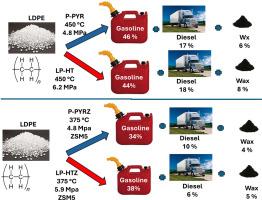Depolymerization of LDPE under low pressure-hydrothermal processing and pressurized pyrolysis: Effect of the ZSM-5 catalyst
引用次数: 0
Abstract
This study compares the performance of autogenous pressurized pyrolysis (P-PYR) and low-pressure hydrothermal liquefaction (LP-HT) for transforming low-density polyethylene (LDPE) into gasoline-range and diesel-range hydrocarbons. Both processes were carried out in a closed reactor, at temperatures from 350 to 450 °C. The effect of ZSM-5 zeolite as a catalyst was also analyzed. The evaluated parameters included the amount of the gas, oil, and wax fractions formed; the chemical composition of the gas and liquid fractions; and the simulated distillations (SIMDIS) of the liquid fractions. The distillation curves obtained by SIMDIS were used to estimate the yield of gasoline range and diesel-range hydrocarbon fractions. In the non-catalyzed processes, all the products had nearly the same composition, indicating that water had a limited effect on the depolymerization process. In the catalyzed processes, there was a slight change in the yield of the recovered products when water was present. The ZSM-5 zeolite also had an impact on the chemical composition of the produced fractions. Without the catalyst, both LP-HT and P-PYR (at 400 °C) produced about 40 % gasoline-range and 25 % diesel-range hydrocarbons, leading to a total yield of fuel-range hydrocarbons of around 65 %. When the ZSM-5 catalyst was used, the recovered oil mostly contained single-ring aromatic compounds, leading to a fuel yield of around 44 % (at 375 °C), with gasoline-range hydrocarbons making up 36–38 % and diesel-range hydrocarbons 6–8 %. The results indicate that ZSM-5 zeolite can alter the makeup of the thermochemical products from LDPE, and at the experimental conditions studied, water only had a limited effect.

低压水热和加压热解下LDPE的解聚:ZSM-5催化剂的影响
本研究比较了自加压热解(P-PYR)和低压水热液化(LP-HT)将低密度聚乙烯(LDPE)转化为汽油级和柴油级碳氢化合物的性能。这两个过程都在一个封闭的反应器中进行,温度从350°C到450°C。分析了ZSM-5沸石作为催化剂的效果。评估参数包括形成的气、油和蜡馏分的数量;气体和液体馏分的化学成分;以及液体馏分的模拟蒸馏(SIMDIS)。利用SIMDIS得到的蒸馏曲线对汽油段和柴油段馏分的产率进行了估计。在非催化过程中,所有产物的组成几乎相同,表明水对解聚过程的影响有限。在催化过程中,当有水存在时,回收产物的产率略有变化。ZSM-5沸石对生产馏分的化学成分也有影响。在没有催化剂的情况下,LP-HT和P-PYR(在400°C下)都能产生约40%的汽油级和25%的柴油级碳氢化合物,导致燃料级碳氢化合物的总收率约为65%。当使用ZSM-5催化剂时,回收的油主要含有单环芳香族化合物,导致燃料收率约为44%(在375°C下),其中汽油范围的碳氢化合物占36 - 38%,柴油范围的碳氢化合物占6 - 8%。结果表明,ZSM-5沸石可以改变LDPE热化学产物的组成,在实验条件下,水的影响有限。
本文章由计算机程序翻译,如有差异,请以英文原文为准。
求助全文
约1分钟内获得全文
求助全文

 求助内容:
求助内容: 应助结果提醒方式:
应助结果提醒方式:


